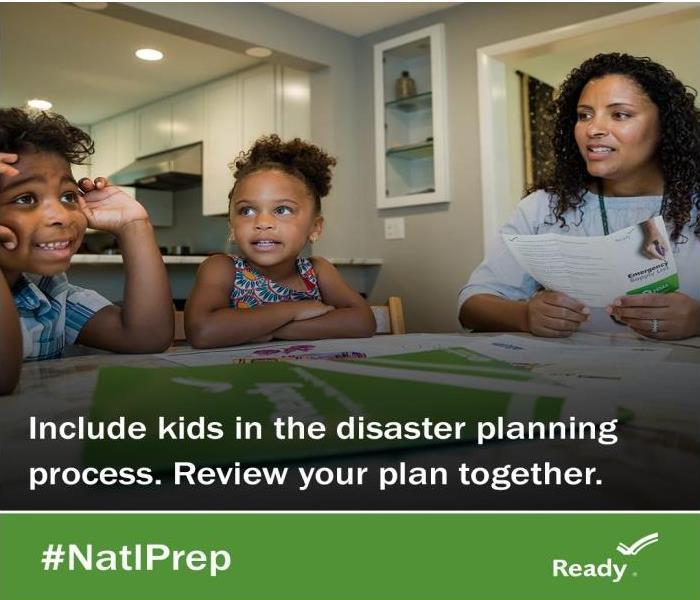National Preparedness Month- Week 4: Teach Youth About Preparedness- Earthquakes.
9/22/2020 (Permalink)
Talk to your kids about preparing for emergencies and what to do in case you are separated. Reassure them by providing information about how they can get involved.
In Riverside County, disasters can hit any time. Two that have impacted the area recently are Earthquakes and Wildfires. With the recent 3.3 earthquake in Lake Elsinore and 4.5 earthquake in South El Monte (that was felt all the way to Beaumont), it's important to be prepared for these events. In light of National Preparedness Month. We will address how to prepare your kids for earthquakes. Next blog will discuss how to prepare you kids for wildfires.
An earthquake is the sudden, quick shaking of the earth. It is caused by rock breaking and moving under the ground. Additional earthquakes, known as aftershocks, can occur for hours, days, or even months after an earthquake. These are usually smaller than the first earthquake. However, they could cause more damage to structures weakened by the first earthquake.
Earthquakes can also cause tsunamis. Tsunamis are a series of waves caused by a large and sudden disturbance of the sea.
Aftershock
Another earthquake that happens after the first earthquake. These are usually smaller than the first earthquake.
Epicenter
The center of an earthquake. Vibrations are sent from the epicenter in many directions.
Fault Lines
Cracks in the rocks below the earth’s surface.
Seismic Activity
This is another word for earthquakes, along with tremors, quakes, and shakers.
Seismograph
A machine that measures an earthquake.
All 50 states and 5 U.S. territories are at some risk for earthquakes. Earthquakes can happen at any time of the year and occur without warning. Scientists are working on a way to detect when an earthquake may happen.
Before
- Build an emergency kit.
- Make a family communications plan.
- Know the safe spots in every room—under a sturdy table or against an inside wall.
- Secure household items.
- Ask your family to hold earthquake drills—drop, cover, and hold on!
During
- If you are inside: DROP to the ground. COVER yourself under a sturdy table or other heavy furniture. If there is nothing to get under, cover your head and neck with your arms and crouch near an inside wall. HOLD ON until the shaking stops.
- If you are using a wheelchair or a walker with a seat: LOCK your wheels. COVER your head and neck with your arms, a pillow, a book, or whatever is available. HOLD ON and maintain your position with your head and neck covered until the shaking stops.
- If you are in bed, stay there and cover your head and neck with a pillow.
- STAY AWAY from windows, glass, lighting fixtures, or furniture that could fall, like bookcases.
- STAY INSIDE! Do not use elevators!
- If you are outside: Stay there. Move away from buildings, streetlights, and wires until the shaking stops. Be very careful before re-entering your home or other buildings. Be sure a parent or adult is with you.
After
- Expect aftershocks. They are usually not as strong but can cause damage.
- Do not enter a damaged building.
- Open cabinets carefully. Objects might have moved and could fall on you.
- Wear long pants, long sleeves, and shoes to protect your skin from getting scratched by broken objects.
- Text, don’t talk. Unless there’s a life-threatening situation, send a text so that you don’t tie up phone lines needed by emergency workers. Plus, texting may work even if cell service is down.
Watch this video with your kids
Ready.gov Earthquake Preparedness Video
Earthquakes are prone to causing other disasters such as water or fire disasters. Keep our number handy:
SERVPRO of West Riverside City
951-351-8033
We are here for you 24/7
We are trained to handle emergency disasters. We have the tools, gear and experience needed to handle water or fire damage.






 24/7 Emergency Service
24/7 Emergency Service
